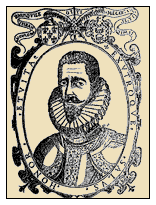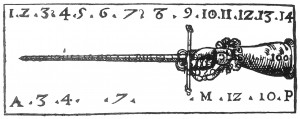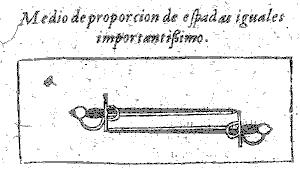Destreza – Choosing a Weapon for the Spanish Tradition
Choose a blade no more than 41.1 inches from cross to tip.
According to the canonical authors, the length of the weapon should be no longer than 5/4 vara. That’s an upper limit just a bit over 41 inches.
Philip II’s Law on Blade Length
| That we are informed that in the said cities, villages, and places some swords, verdugos and estocs are carried of more than six and seven and eight palms and from there above in length, from which cause many inconveniences and deaths of men have resulted and continue to result, and wanting to provide a remedy to this, discussed in our council and with us consulted, it was agreed that we should order this our letter to be issued for you for the stated reason, and we considered it as good. Because of this, we order and command that now and from here forward, after fifteen days counted from the day of the publication of this our letter, no one of whatever quality and condition that he might be should dare to carry nor will carry the said swords, verdugos nor estocs of greater than five fourths of vara of blade in length, under penalty that he who carries it falls and incurs for the first time in penalty of ten ducats and ten days in jail and loss of that estoc, verdugo, or sword, and for the second the penalty is doubled and one year of exile from the city, village, or place where he is taken and was neighbor… |
Pacheco de Narváez’s Preference on Blade Length
Later, Luis Pacheco de Narváez directly cites Philip’s law in his books.
| From these and other injuries our King and Lord Philip, Second in name and First in religion and prudence (whose happy memory in these glorious attributes will live in the most extended posterity of men), wanted to free them, justly and compassionately, with paternal love prohibiting under precept and force of law that any of his vassals carry sword, verdugo or estoc, of more blade than five fourths of vara, superior reason he achieved for this establishment, and if it were as justifiable for us to investigate it, as the obligation of obeying it, we would dare to say, that knowing for the organization, symmetry, and composure of the man (leaving the extremes of high and low) that his common stature is two varas in length, like he also has them from the extreme of one hand to the other, the arms open, and that in this all natural is in potential and diffuse action the strength of the parts that constitute him, unless the ones to the others their similar ones, they can communicate what they receive, and that from the left shoulder to the extremity of the right hand there are five fourths, he wanted for universal good that the swords were of this length, knowing that if they exceeded this, it would not be powerful the vigor sent to move them with the suitable quickness; and thus this very wise Prince looked for a proportion so proportionate that one will not find another more proportionate. |
In the seventeenth century, Pacheco de Narváez echoes the sentiments of Philip II in recommending a blade no more than 5/4 varas.
Pacheco de Narvaez’s Opinions on Longer Blades
Knowing that Pacheco de Narváez advocates a blade no longer than 5/4 vara, does he consider it important? If you use a longer weapon against someone using a proper sword, it offends Pacheco de Narváez, and he has some harsh things to say.
| The affection of our desire will remain offended and with just reason upset if we lose the opportunity of attempting the inconvenient reform of an ancient error introduced in men, about whom without exceeding the limits of modesty one can speak with all contempt, and in others, that all the terms that human courtesy have discovered do not equal its quality and merits. This is the exorbitant excess in the quantity and length of the swords, so much that changing the gender from feminine to masculine, requires it to be called estoc, or with a word of less nobility verdugo, from the problems that are offered, some are related to and offend the reputation and others offer manifest dangers. Firstly, it is known that no one ever spoke with venerable respect nor did the valor remain very esteemed of he who with advantageous weapons attacked his opponent in a forewarned or casual fight. From the fifth generation passes his memory and easy cause provokes, so that in absence or present they give him in the face with the ugliness of this injury. The greatest friend fails to rise in his defense and with honorable respects is ashamed to promote his credit. He who is not a friend speaks with indignity and discourtesy, and the neutral person is inclined toward kindness and compassion for he who suffered with the unequal instrument, without placing the misfortune of the case to the charge of not knowing. If the cause is deduced to judgment, the right makes the guilt worse and with just indignation increases the sentence and punishment, and in taking this into account, competing with time and forgetfulness endures this new word – fraud, disparaging insult with which the people discredit the one who with effeminate spirit does not dare to confront another man without the advantageous disparity that the estoc has in length over the sword. With similar events it comes to mind and renews resentment, and those who deserve praise detest and condemn it again…” |
To summarize, blades longer than 5/4 vara:
- Are offensive, immodest, excessive, and contemptible.
- Will damage your own reputation by decreasing the perception of your valor for 5 generations.
- Cause friends to be too ashamed to speak on your behalf, enemies to disparage you, and neutral parties to favor your adversary.
- In losing, having chosen a longer weapon will cause your guilt to be worsened and the sentence and punishment is increased (judicially speaking).
- Cause you to be viewed as effeminate for not confronting your adversary on equal terms.
- Are regarded by the the people who are praiseworthy as detestable, and they condemn it.
He also goes on about how shorter blades and lighter blades are better for reacting to the adversary and more macho. Practically speaking, the blade should be able to deliver powerful cuts but still be light enough to change direction quickly.
My own opinion is that in an engagement of the weapons, it is useful to be able to cross and uncross your arms as well. To see what I mean carry your sword over your left arm and then grab a friend’s doublet with your left hand. Uncross your arms to bring your point in line with your friend’s chest. This is easier when the blade is shorter and a sidesword fills the role nicely.
Other Authors
The weapon images in the texts of Carranza (1569) and Pacheco de Narváez (1600 – approx. 1630s) show us swords that look different from the long slender rapiers in Thibault. At least in the time period of Carranza and possibly Pacheco de Narváez as well “Spanish rapier” isn’t a precise description of what I would personally consider an edge sword or side sword if you prefer.
Even as late as Francisco Lórenz de Rada’s work in the late 1600s and early 1700s, 5/4 vara is the maximum length. That being said, Girard Thibault‘s work is outside the Spanish canon so if you are interested primarily in Thibault, exceeding 5/4 vara might be acceptable.
Science versus Specific Tradition
Destreza theory is a science which can describe all types of martial arts. The Spanish tradition of swordplay is what is most often described with this science. We must not confuse the science with the specific practice of the art. Pacheco de Narváez and Carranza practice the Spanish tradition, and we can describe this with Destreza fencing theory, but that science is also used as a tool for analyzing Italian fencing and other forms as well.
While Pacheco de Narváez and the other authors recommend a sword of 5/4 vara or less for the martial tradition, Destreza doesn’t recognize a limit on weapon size from the perspective of the science. The montante and other weapons will obviously surpass this value, and Destreza still applies.






[…] Update: Thanks to readers Ville Siivola and Sean Manion for each sending a link to an article by Puck and Mary Curtis that shares a similar proclamation made two years earlier by Phillip II of Spain. Check that article out here. […]
By Devon Boorman | Choosing the Right Rapier for You on October 15, 2017 4:53 pm